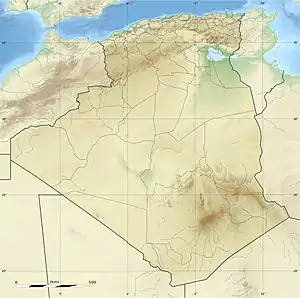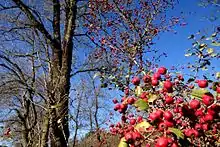| El Kala National Park | |
|---|---|
 | |
 | |
| Location | El Tarf Province, Algeria |
| Nearest city | El Kala |
| Coordinates | 36°49′N 8°25′E / 36.817°N 8.417°E |
| Area | 764 km² |
| Established | 1993 |
| Visitors | 30,000 (in 2001) |
| Official name | Réserve Intégrale du Lac Oubeïra |
| Designated | 11 April 1983 |
| Reference no. | 280[1] |
| Official name | Réserve Intégrale du Lac Tonga |
| Designated | 11 April 1983 |
| Reference no. | 281[2] |
| Official name | Tourbière du Lac Noir |
| Designated | 4 June 2003 |
| Reference no. | 1305[3] |
| Official name | Réserve Intégrale du Lac El Mellah |
| Designated | 12 December 2004 |
| Reference no. | 1424[4] |
| Official name | Marais de Bourdim |
| Designated | 18 December 2009 |
| Reference no. | 1895[5] |
The El Kala National Park and Biosphere Reserve (Arabic: محمية القالة الوطنية) is one of the national parks of Algeria in the extreme north-east of the country. It is home to several lakes and a unique ecosystem in the Mediterranean basin. Several parts of the park have been designated as protected Ramsar sites.[1][2][3][4][5]
History
The El Kala National Park and Biosphere Reserve was created by decree n° 83-462 of July 23, 1983, and recognized as a biosphere reserve by the UNESCO on 17 December 1990.[6]
From 1994 to 1999, the World Bank financed a project to develop a natural resources management model for the park.[7]
Geography
The park's highest hill is djebel El-Ghorra at 1202 m. The average temperature goes from 9 °C to 30 °C. The park has 50 km of shores facing the Mediterranean Sea.[6]
The park has 6 lakes:[6]
Biosphere
The El Kala National Park and Biosphere Reserve is home to 40 species of mammals, 25 bird of prey species, 64 freshwater bird species and 9 marine bird species.[8] The Barbary stag is prevalent in the park.
An investigation led between 1996 and 2010 listed 1590 different types of vegetables in the park and 718 animal species. The main tree species are the Quercus suber (dominant), the Zeen oak, the Quercus coccifera, the Aleppo pine, the glutinous Alder, Willows, the White Poplar. Other tree species in the park include Eucalyptus, Acacias, Maritime pines and bald cypresses. 175 species of mushrooms were listed.[6]
The park is threatened by the creation of a highway in Algeria which would threaten the rare animals and plants of the park. It has been proposed that the highway should avoid this region and go further south.[9]
Gallery
 Rainbow in the park
Rainbow in the park Walkway through the lake
Walkway through the lake Blue Lake
Blue Lake Lake Tonga
Lake Tonga Glossy ibis in the park
Glossy ibis in the park Greater flamingos in the park
Greater flamingos in the park Cytinus hypocistis in the park
Cytinus hypocistis in the park Gladiolus communis in the park
Gladiolus communis in the park Crataegus laevigata in the park
Crataegus laevigata in the park
Human population
87,000 people live in the El Kala National Park and Biosphere Reserve.[10]
Tourism
The park averaged 30,000 visitors in 2001.[10]
References
- 1 2 3 "Réserve Intégrale du Lac Oubeïra". Ramsar Sites Information Service. Retrieved 11 September 2018.
- 1 2 3 "Réserve Intégrale du Lac Tonga". Ramsar Sites Information Service. Retrieved 11 September 2018.
- 1 2 3 "Tourbière du Lac Noir". Ramsar Sites Information Service. Retrieved 11 September 2018.
- 1 2 3 "Réserve Intégrale du Lac El Mellah". Ramsar Sites Information Service. Retrieved 11 September 2018.
- 1 2 3 "Marais de Bourdim". Ramsar Sites Information Service. Retrieved 11 September 2018.
- 1 2 3 4 Sarri Djamel, Djellouli Yamna, Allatou Djamel, Biological diversity of the National Park of El-Kala (Algeria), valorization and protection, Researchgate.net, 2014
- ↑ Report Number:ICRR10646, Worldbank.org, 20 June 2000
- ↑ World Guide. "Algeria National Parks and Reserves". Retrieved 2 July 2011.
- ↑ France 24 (14 June 2008). "A highway threatens El Kala National Park". Archived from the original on 9 February 2011. Retrieved 2 July 2011.
{{cite web}}: CS1 maint: numeric names: authors list (link) - 1 2 UNESCO. "El Kala". Retrieved 2 July 2011.